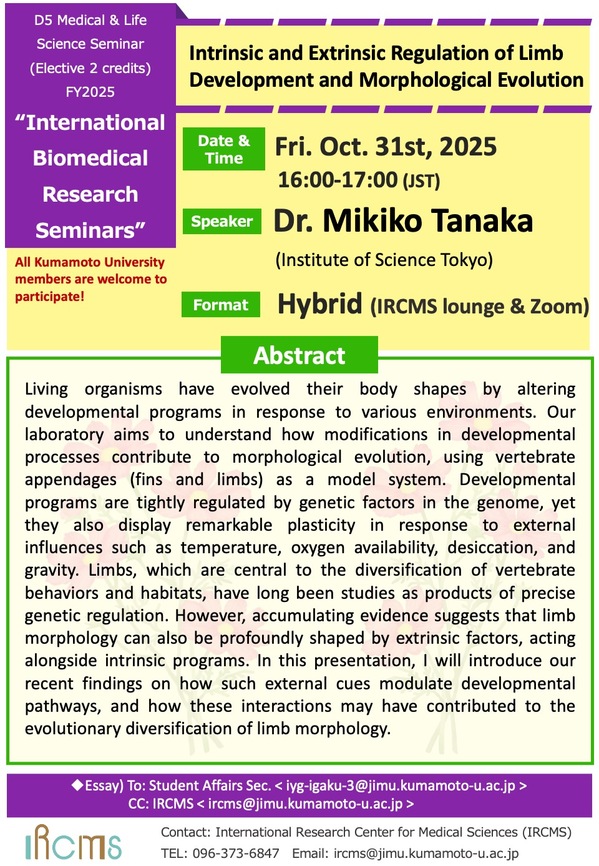- HOME
- News & Events
- [Oct. 31] D5 Seminar - Dr. Mikiko Tanaka (Institute of Science Tokyo)
News & Events
[Oct. 31] D5 Seminar - Dr. Mikiko Tanaka (Institute of Science Tokyo)
October 1 2025
The "D5 Medical & Life Science Seminar" course will be offered by International Research Center for Medical Sciences (IRCMS). It will run from May 2025 to March 2026, with lectures given by scientists who are affiliated with IRCMS or in collaboration with researchers at IRCMS. The lectures will be given once a month, in English, and by leading scientists in the relevant research field. Students will be taught: 1) how normal physiological functions are maintained in the human body; 2) how these systems become abnormal under certain pathophysiologic conditions; 3) why stem cells are important in animal development and homeostasis; 4) how stem cell-based approaches can help us understand disease mechanisms and find potential cure for diseases related to stem cell malfunction (e.g., cancer, aging).
Anyone who wants to join is welcome.
For students who have registered for the course, please check your attendance in Moodle.
Date : October 31st, 2025 (Friday)
Format : Hybrid (IRCMS lounge and zoom)
Time : 16:00 - 17:00 (JST)
Speaker : Dr. Mikiko Tanaka (Institute of Science Tokyo)
Title : Intrinsic and Extrinsic Regulation of Limb Development and Morphological Evolution
Abstract :
Living organisms have evolved their body shapes by altering developmental programs in response to various environments. Our laboratory aims to understand how modifications in developmental processes contribute to morphological evolution, using vertebrate appendages (fins and limbs) as a model system. Developmental programs are tightly regulated by genetic factors in the genome, yet they also display remarkable plasticity in response to external influences such as temperature, oxygen availability, desiccation, and gravity. Limbs, which are central to the diversification of vertebrate behaviors and habitats, have long been studies as products of precise genetic regulation. However, accumulating evidence suggests that limb morphology can also be profoundly shaped by extrinsic factors, acting alongside intrinsic programs. In this presentation, I will introduce our recent findings on how such external cues modulate developmental pathways, and how these interactions may have contributed to the evolutionary diversification of limb morphology.
Major Papers:
- Eriko Tsuboi, Satomi F Ono, Ingrid Rosenburg Cordeiro, Reiko Yu, Toru Kawanishi, Makoto Koizumi, Shuji Shigenobu, Guojun Sheng, Masataka Okabe, and Mikiko Tanaka (2024). Immobilization secondary to cell death of muscle precursors with a dual transcriptional signature contributes to the emu wing skeletal pattern. Nat Communs 15, Article number 8153.
- Ingrid Rosenburg Cordeiro, Kaori Kabashima, Haruki Ochi, Keijiro Munakata, Chika Nishimori, Mara Laslo, James Hanken, and Mikiko Tanaka (2019). Environmental oxygen exposure allows for the evolution of interdigital cell death in limb patterning. Dev Cell 50, 155-166.
- Eri Okamoto, Rie Kusakabe, Shigehiro Kuraku, Alexandre Robert-Moreno, Koh Onimaru, James Sharpe, Shigeru Kuratani, and Mikiko Tanaka (2017). Migratory appendicular muscles precursor cells in the common ancestor to all vertebrates. Nat Ecol Evol 1, 1731-1736.
Flyer: (Click to enlarge)

